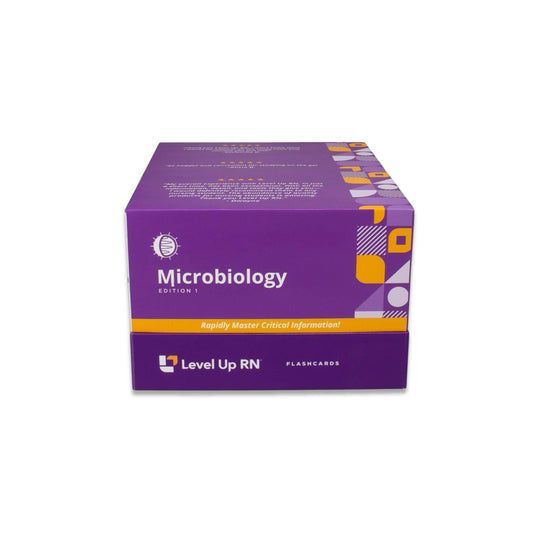DNA replication in a prokaryotic cell; semiconservative replication and the steps involved in semiconservative replication (i.e., initiation, elongation, and termination). The various enzymes involved in the replication process (e.g., gyrase, helicase, RNA primase, DNA polymerase). Key differences in DNA replication in a eukaryotic cell vs. a prokaryotic cell.
Microbiology, part 33: Genetics - DNA Replication
Full Transcript: Microbiology, part 33: Genetics - DNA Replication
Full Transcript: Microbiology, part 33: Genetics - DNA Replication
Hi. I'm Cathy with Level Up RN. In this video, I will be discussing DNA replication in a prokaryotic cell, which is a key topic that you definitely have to know for your micro class. We will also be covering some of the key differences between DNA replication in a prokaryotic cell versus a eukaryotic cell. At the end of the video, I'm going to give you guys a little quiz to test your understanding of some of the key facts I'll be covering, so definitely stay tuned for that. And if you have our Level Up RN microbiology flashcards, go ahead and pull out your flashcards on DNA replication so you can follow along with me, and pay close attention to the bold red text on the back of the cards because those are the things that you are likely to get tested on.
DNA is replicated in a process referred to as semiconservative replication. During semiconservative replication, the two strands of the DNA double helix separate, and each strand serves as a template to make a new complementary strand. After replication, each new double-stranded DNA molecule includes one parental DNA strand and one daughter DNA strand.
Let's now do an overview of the steps involved in semiconservative replication. Replication begins at the origin of replication. The supercoil DNA is first relaxed by an enzyme called gyrase. Then another enzyme, called helicase, unwinds and separates the DNA into two single strands. And then proteins stabilize the unwound DNA, which prevents it from rewinding back into a double helix. Next, RNA primase, which is another enzyme, synthesizes short RNA primers, which are complementary to the parental DNA strand. Once the RNA primers are in place, then DNA polymerase 3, yet another enzyme, comes in to extend the primers, adding nucleotides in the 5 prime to 3 prime direction only. The leading strand, at the top of the image, only requires one RNA primer and is synthesized continuously. The lagging strand, at the bottom of the image, however, is synthesized discontinuously in short segments called Okazaki fragments. Each of these fragments must start with its own RNA primer.
In order to see the difference between the leading strand and lagging strand, let's take a look at my zipper and pretend that it's DNA. So as the zipper opens, this is my replication fork. And this is my leading strand over here, and this is my lagging strand on this side. So on the leading strand, I can just follow this zipper all the way down and add new nucleotides in a continuous manner because I am adding them in the 5 prime to 3 prime direction. I cannot do this on the lagging strand, however, because I need to add them in the opposite direction. So with the lagging strand, I have to wait for the zipper to come down, and then I can add a little segment like this. And then I wait for it to come down a little more, and then I can add another segment. Wait for it to come down and add yet another segment, and so on. So you can see with the lagging strand, this is synthesized discontinuously in those segments, as opposed to the leading strand, which can be synthesized in one segment.
As DNA synthesis continues, the RNA primers, including all those RNA primers on the lagging strand, are replaced with DNA. This is done by an enzyme called DNA polymerase 1. It's important to note that after replacement of the RNA primers, there will be little nicks in the newly synthesized DNA strand. And those nicks need to be sealed by an enzyme called DNA ligase, which joins the DNA segments. In a prokaryotic cell, DNA replication proceeds in both directions around the circular chromosome. Eventually, the replication forks will meet, and that is when DNA synthesis is discontinued. The two circular genomes are then separated by topoisomerase 4, which, you guessed it, is another enzyme.
Let's now review some key differences between DNA replication in a eukaryotic cell as opposed to a prokaryotic cell. So one big difference is that eukaryotic cells contain multiple linear chromosomes, and there are multiple origins of replication on each chromosome. This is different than prokaryotic cells, which contain one circular chromosome with one origin of replication on the chromosome. Another key difference is that eukaryotic chromosomes contain telomeres, whereas prokaryotic chromosomes do not. So telomeres are regions of noncoding repetitive sequences at the end of the chromosomes. And these regions help to protect coding sequences from being lost during cell division.
All right. It's quiz time, and I have four questions for you. Question number one, which enzyme unwinds and separates the DNA helix into two single strands? The answer is, helicase. Number two, are new nucleotides added in the 5 prime to 3 prime direction or the 3 prime to 5 prime direction? The answer is, in the 5 prime to 3 prime direction only. Question number 3, the lagging strand is synthesized discontinuously in blank fragments. The answer is, Okazaki. And number four, blank are regions of noncoding repetitive sequences at the end of the chromosome in a eukaryotic cell. The answer is, telomeres.
All right. That's it for this video. I hope it was helpful. Take care, and good luck with studying.
[BLOOPERS]
As opposed to the leading strand where I just followed that zipper down and added those [inaudible]. I can just follow my zipper down and add [inaudible].


